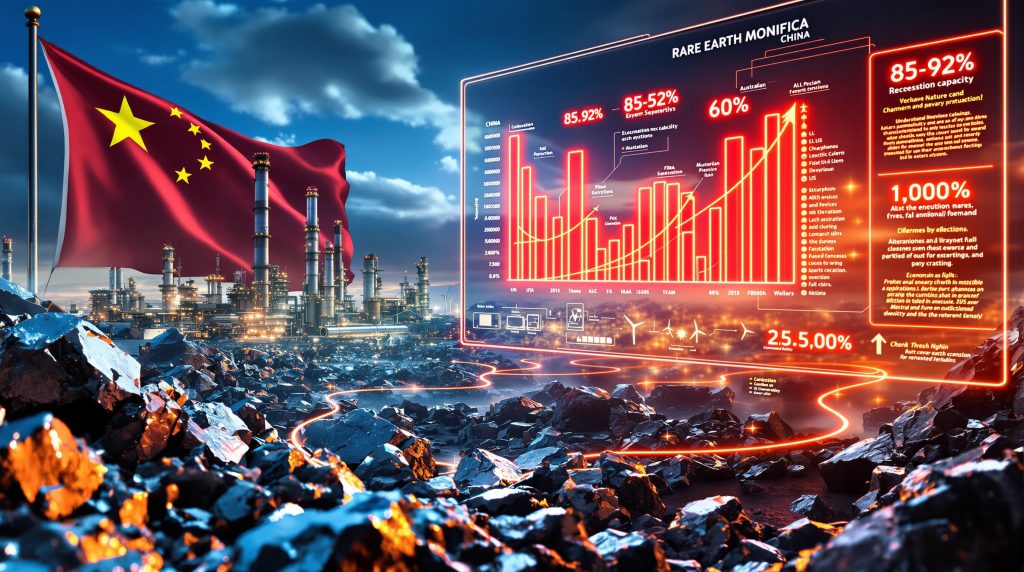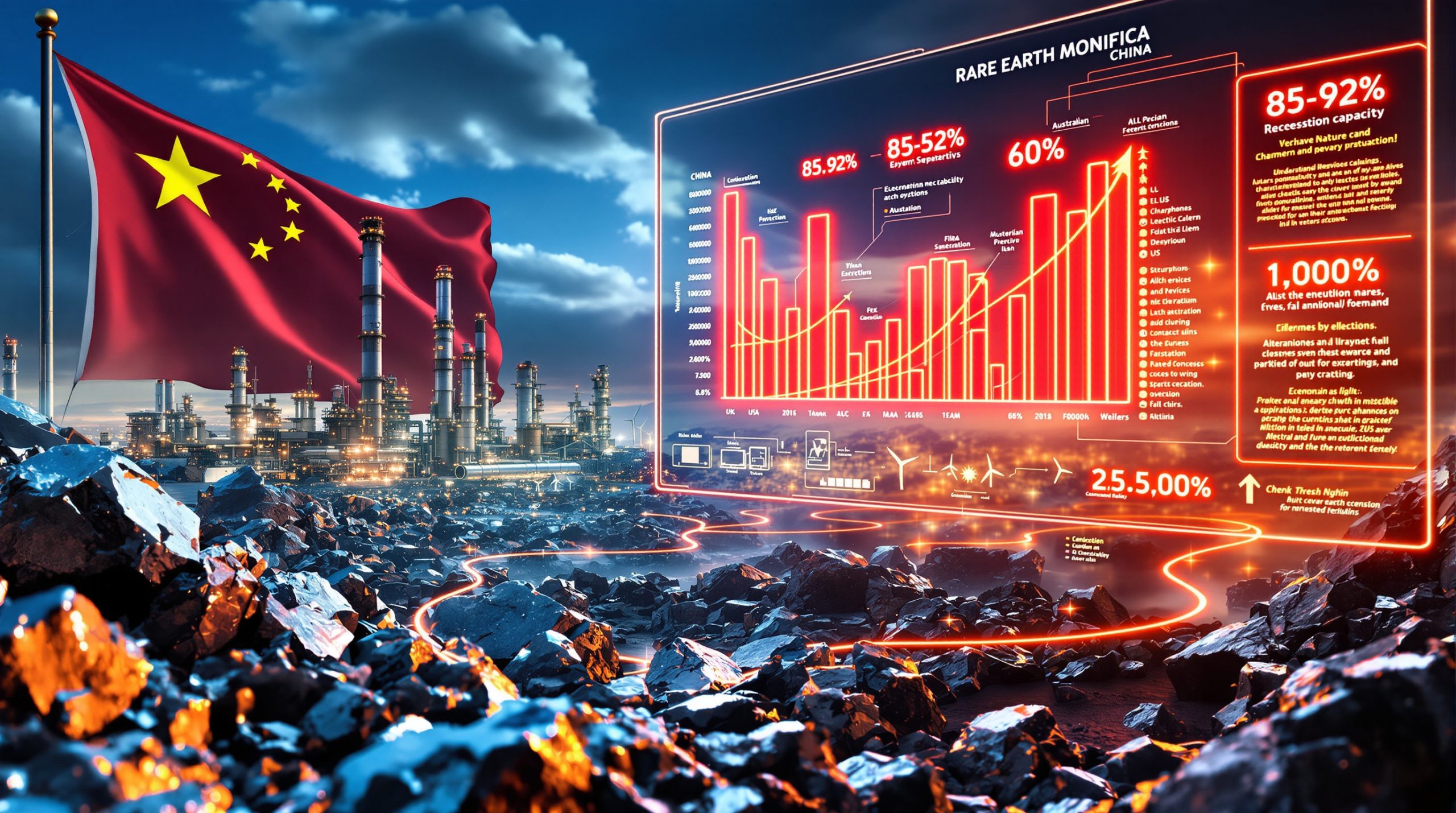Understanding the Strategic Dynamics of Rare Earth Dependencies
The global technology landscape stands at a critical inflection point where China's grip on rare earths has evolved into a sophisticated instrument of economic statecraft. While much attention focuses on semiconductors and consumer electronics, the true vulnerability lies deeper within the industrial architecture that powers modern defense systems, renewable energy infrastructure, and precision manufacturing.
This dependency extends far beyond simple mining operations. The strategic chokepoint exists within the chemical separation, purification, and advanced manufacturing processes that transform raw rare earth ores into the high-specification materials essential for contemporary technology. Understanding this distinction proves crucial for assessing both current vulnerabilities and potential pathways toward supply chain resilience.
The Architecture of Chinese Rare Earth Dominance
China's control over rare earth elements represents one of the most comprehensive resource monopolies in modern industrial history. The nation commands approximately 85-92% of global rare earth processing capacity while maintaining 60-70% of worldwide mining operations, according to the United States Geological Survey's 2024 Mineral Commodity Summaries.
This dominance encompasses all 17 rare earth elements, which include the 15 lanthanides plus scandium and yttrium. These elements are typically classified into two categories:
-
Light Rare Earths (LREE): Lanthanum, Cerium, Praseodymium, Neodymium, Promethium, Samarium, Europium
-
Heavy Rare Earths (HREE): Gadolinium, Terbium, Dysprosium, Holmium, Erbium, Thulium, Ytterbium, Lutetium
Processing Infrastructure Monopoly
Unlike commodity markets where multiple nations can refine raw materials, China has systematically constructed the world's only large-scale rare earth separation and refinement infrastructure. This processing capability requires specialised knowledge in solvent extraction, fractional crystallisation, and ion-exchange chromatography technologies developed over decades of operational experience.
Regional Processing Distribution in China:
| Region | Processing Capacity Share | Specialisation |
|---|---|---|
| Inner Mongolia | ~40% | Light rare earths, integrated mining |
| Guangdong | ~30% | Heavy rare earths, high-purity separation |
| Sichuan/Gansu/Fujian | ~30% | Mixed operations, specialised applications |
The complexity of rare earth separation cannot be understated. Each processing step requires:
-
Acid leaching of mineral concentrates
-
Multi-stage solvent extraction with proprietary chemical formulations
-
Crystallisation processes to achieve >99.9% purity levels
-
Environmental remediation systems for radioactive thorium waste and acidic effluent management
Vertical Integration Strategy
China's strategic advantage extends through complete vertical integration from extraction to final product manufacturing. This encompasses:
-
Raw Material Control: Mining operations across multiple provinces
-
Chemical Separation: Proprietary separation and purification facilities
-
Metal Production: Conversion of oxides to metallic forms
-
Magnet Manufacturing: Production of neodymium-iron-boron (NdFeB) permanent magnets
-
Component Integration: Assembly into motors, actuators, and precision devices
-
Final Product Assembly: Integration into consumer electronics, industrial equipment, and defence systems
Export Controls as Instruments of Economic Warfare
China's approach to rare earth export restrictions has evolved from basic quota systems to sophisticated licensing mechanisms that provide granular control over global supply chains. This evolution represents a fundamental shift in how resource-rich nations can leverage their advantages in an interconnected world economy.
Timeline of Control Mechanism Evolution
Historical Progression:
| Year | Control Measure | Strategic Impact |
|---|---|---|
| 1990 | Strategic goods classification | Foundation for future controls |
| 2010 | Export quota reduction (72% cut) | First major supply disruption |
| 2015 | WTO case settlement | Shift to licensing systems |
| 2023 | Gallium/Germanium controls | Semiconductor supply chain targeting |
| April 2025 | Heavy rare earth licensing | Direct targeting of defence applications |
| October 2025 | Expanded element coverage | Broader industrial impact |
| November 2025 | Extraterritorial provisions | Global supply chain regulation |
Revolutionary Extraterritorial Provisions
The November 2025 expansion marked an unprecedented escalation through the introduction of extraterritorial licensing requirements. These provisions attempt to regulate:
-
Global Manufacturing: Products containing Chinese-origin rare earth materials regardless of manufacturing location
-
Technology Transfer: Processes derived from or utilising Chinese rare earth separation methodologies
-
Supply Chain Documentation: Comprehensive traceability requirements for downstream manufacturers
This represents a departure from traditional export controls that regulate only goods leaving the exporting country's territory, effectively extending Chinese regulatory authority into global supply chains.
Critical Industry Vulnerabilities
The strategic implications of China's grip on rare earths manifest most acutely across several high-stakes industries where alternative materials or suppliers remain limited or economically unfeasible. Furthermore, the defense critical materials strategy demonstrates how national security considerations intersect with supply chain vulnerabilities.
Defence and Aerospace Applications
Military applications represent the highest-stakes dependencies on Chinese rare earth supplies, with limited flexibility for material substitution due to stringent performance requirements.
Critical Defence Applications:
| System Type | Primary Elements | Annual Consumption | Strategic Impact |
|---|---|---|---|
| Guided munitions | Dy, Tb, Nd | 50-100 tons | Mission-critical guidance |
| Radar systems | Nd, Dy | 200-300 tons | Detection capabilities |
| Fighter aircraft | Dy, Tb coatings | 100-150 tons | Engine performance |
| Naval propulsion | NdFeB magnets | 300-500 tons | Fleet operations |
| Satellite systems | Sm-Co magnets | 20-50 tons | Space-based assets |
Precision-Guided Munitions Dependency:
Modern precision-guided munitions rely extensively on NdFeB magnets enhanced with dysprosium and terbium for guidance system servos and actuators. A single cruise missile may contain 2-5 kilograms of high-specification NdFeB magnets, representing substantial rare earth content across thousands of units in military inventories.
Renewable Energy Infrastructure
The transition to renewable energy systems has created substantial dependencies on rare earth permanent magnets, particularly in wind turbine generators and electric vehicle drive systems. Additionally, the relationship between energy transition & critical minerals highlights these interconnected vulnerabilities.
Wind Energy Sector:
-
Direct-drive wind turbines: 200-600 kg of rare earth magnets per turbine
-
Global capacity additions: ~100 GW annually (2024)
-
Annual rare earth demand: 40,000-60,000 metric tons for wind sector
Electric Vehicle Market:
-
EV motor content: 0.5-1.0 kg of NdFeB magnets per vehicle
-
Global EV production: 14.0 million units (2023)
-
Sector rare earth consumption: 7,000-14,000 metric tons annually
Technology Manufacturing Dependencies
Consumer electronics and telecommunications infrastructure incorporate rare earth elements across multiple components and systems:
Smartphone Production:
-
Vibration motors: NdFeB magnets for haptic feedback
-
Speaker systems: Dysprosium and terbium for acoustic components
-
Camera systems: Rare earth elements in focusing mechanisms
-
Global production volume: ~1.2 billion units annually
Semiconductor Manufacturing Equipment:
Beyond consumer applications, semiconductor fabs rely on rare earth magnets in extreme ultraviolet (EUV) lithography systems, ion implantation equipment, and precision alignment mechanisms, creating second-order vulnerabilities in advanced chip production.
Economic Disruption and Market Volatility
Rare earth markets exhibit extreme price volatility due to supply concentration, limited substitutability, and relatively small market sizes compared to major commodity markets. This volatility has severe downstream economic effects across technology-dependent industries.
Historical Price Volatility Patterns
Major Price Disruption Events:
| Period | Trigger Event | Price Impact | Recovery Timeline |
|---|---|---|---|
| 2010-2011 | Japan earthquake + China quotas | 500-800% increases | 18-24 months |
| 2015-2017 | Oversupply correction | 60-80% declines | 12-18 months |
| 2020-2021 | COVID supply disruption | 100-200% increases | 6-12 months |
| 2025 | Export licensing implementation | 150-300% increases | Ongoing |
2011 Historical Reference Point:
During the most severe disruption on record, dysprosium oxide pricing reached $2,600 per kilogram from approximately $300 per kilogram in 2010, representing an 867% increase. Terbium oxide experienced similar volatility, demonstrating the extreme price elasticity inherent in these markets.
Manufacturing Cost Transmission Mechanisms
When rare earth prices increase dramatically, manufacturers face several strategic responses:
-
Inventory Hedging: Increased working capital requirements for strategic stockpiling
-
Product Redesign: Engineering efforts to reduce rare earth content or substitute alternative materials
-
Supply Chain Diversification: Accelerated programs to develop non-Chinese suppliers
-
Price Transmission: Passing increased costs to downstream customers and consumers
The time lag between rare earth price increases and final product price adjustments typically ranges from 3-9 months, depending on inventory levels and contract structures within specific supply chains.
Western Response and Alternative Supply Development
Recognition of rare earth supply vulnerabilities has catalysed significant Western investment in alternative supply chains, recycling technologies, and strategic stockpiling programs. However, can the West break China's grip on rare earths remains a critical question for policymakers and industry leaders.
Current Diversification Initiatives
Major Non-Chinese Projects:
| Company/Region | Project Type | Capacity Target | Timeline |
|---|---|---|---|
| Lynas (Australia) | Integrated mining/separation | 10,500 tpa REO | Operational expansion |
| MP Materials (USA) | Domestic separation facility | 5,000 tpa separated products | 2025-2026 |
| Iluka (Australia) | Heavy rare earth refinery | 1,200 tpa HRE | 2026-2027 |
| Proterial (Japan) | Magnet manufacturing | 3,000 tpa NdFeB magnets | Operational |
Recycling Technology Development:
Advanced recycling initiatives are gaining momentum through companies developing circular economy solutions. These technologies can potentially recover 70-90% of rare earth content from end-of-life products, representing a pathway to supply 25-30% of global demand within a decade if scaled appropriately.
European Union Critical Raw Materials Act
The EU's comprehensive response includes legally binding targets for supply chain diversification, supported by the European CRM Facility:
2030 Strategic Targets:
-
10% domestic extraction of rare earth requirements
-
40% domestic processing capacity for critical applications
-
25% recycling rates for rare earth recovery
-
Maximum 65% reliance on any single external supplier
These targets represent ambitious goals requiring substantial public and private investment coordination across member states.
Strategic Stockpiling Programs
US Defence Production Act Initiatives:
The United States has allocated funding for rare earth stockpiling and domestic production capacity through Defence Production Act authorities, though specific allocation amounts require verification from Federal Register publications.
Japanese Strategic Reserve Program:
Japan maintains strategic reserves of rare earth materials and has expanded public-private partnerships with Australian suppliers to reduce Chinese dependencies. Similarly, Australia's strategic reserve initiatives are becoming increasingly important for regional supply security.
Technology Alternatives and Innovation Pathways
Scientific research into alternative magnet technologies and rare earth substitution offers potential pathways to reduce Chinese supply dependencies, though most alternatives involve performance trade-offs or cost increases. The critical minerals pivot strategy explores these emerging opportunities.
Alternative Magnet Technologies
Iron Nitride Permanent Magnets:
-
Advantages: Rare earth-free composition, high theoretical energy product
-
Limitations: Temperature stability challenges, manufacturing scalability issues
-
Development timeline: 5-10 years to commercial viability
Samarium-Cobalt Magnets:
-
Advantages: High temperature performance, reduced Chinese dependency
-
Limitations: Higher material costs, lower maximum energy product than dysprosium-enhanced NdFeB
-
Current applications: Aerospace and high-temperature industrial applications
Recycling Technology Innovations
Advanced Recovery Processes:
-
Hydrometallurgical separation: Acid-based recovery with >85% efficiency rates
-
Pyrometallurgical processing: High-temperature recovery for magnet alloys
-
Biotechnology approaches: Bacterial leaching for selective element recovery
Economic Feasibility Thresholds:
Rare earth recycling becomes economically competitive when primary material prices exceed approximately $200-400 per kilogram for light rare earths and $800-1,200 per kilogram for heavy rare earths, depending on recycling technology and feedstock availability.
Geopolitical Implications and Resource Diplomacy
China's grip on rare earths provides significant leverage in international relations, representing a form of resource diplomacy that extends beyond traditional trade relationships into strategic technology partnerships and defence cooperation agreements.
Strategic Leverage Mechanisms
Technology Transfer Requirements:
China can condition rare earth access on technology sharing arrangements, joint venture requirements, or intellectual property transfer agreements, particularly in advanced manufacturing sectors.
Investment Condition Setting:
Access to critical rare earth supplies can be linked to broader investment commitments, infrastructure partnerships, or strategic cooperation agreements that extend beyond the rare earth sector.
Alliance Building for Resource Security
Quad Partnership Initiatives (US, Japan, Australia, India):
-
Rare earth supply chain mapping and risk assessment
-
Joint stockpiling and emergency sharing agreements
-
Coordinated investment in alternative supply development
-
Technology sharing for recycling and substitution research
EU-Canada Critical Minerals Agreement:
The European Union and Canada have established a strategic partnership for critical mineral development, including rare earth elements, that aims to reduce European dependency on Chinese supplies through preferential trade arrangements and joint investment programs.
Future Scenarios and Strategic Implications
Multiple potential outcomes exist for the evolution of global rare earth supply chains, each carrying distinct implications for technology companies, defence contractors, and government strategic planning.
Scenario 1: Continued Chinese Dominance (High Probability)
Key Characteristics:
-
China maintains 80-85% processing market share through 2030
-
Export licensing becomes standardised practice across all rare earth elements
-
Western diversification efforts achieve limited scale due to cost and technical challenges
-
Technology companies accept higher costs and supply chain complexity
Investment Implications:
Chinese rare earth companies maintain pricing power and market leadership. Western alternative suppliers achieve niche positions but struggle to compete on cost for high-volume applications.
Scenario 2: Successful Western Diversification (Medium Probability)
Key Characteristics:
-
Alternative supply chains achieve 30-40% market share by 2030
-
Recycling technologies reach commercial scale for 20-25% of demand
-
Government support programmes successfully catalyse private investment
-
Chinese market share declines to 60-70% range
Investment Implications:
Balanced market structure emerges with multiple viable suppliers. Price volatility decreases as supply sources diversify. Premium pricing for "conflict-free" rare earth supply chains develops.
Scenario 3: Technology Breakthrough (Medium-Low Probability)
Key Characteristics:
-
Alternative magnet technologies achieve commercial viability at scale
-
Recycling efficiency approaches 80-90% for most applications
-
Rare earth demand growth decelerates due to substitution
-
Chinese processing dominance becomes less strategically relevant
Investment Implications:
Fundamental market transformation occurs. Traditional rare earth suppliers face demand destruction while technology companies developing alternatives capture substantial value.
Investment Implications and Market Opportunities
The rare earth sector presents complex investment opportunities characterised by high volatility, regulatory uncertainty, and significant capital requirements, but also potential for substantial returns in successful alternative supply development.
High-Growth Investment Themes
Non-Chinese Rare Earth Producers:
-
Australian integrated projects: Lynas, Iluka, and emerging developers
-
North American capacity: MP Materials and potential Canadian developments
-
African exploration: Potential new supply sources in Tanzania, Burundi, and Greenland
Alternative Technology Developers:
-
Magnet technology companies: Developing rare earth-free or reduced rare earth permanent magnets
-
Recycling technology firms: Advanced separation and recovery processes
-
Supply chain management: Traceability and risk management technology providers
Risk Assessment Framework
Investment Decision Factors:
-
Regulatory Risk: Export control changes, environmental permitting, trade policy shifts
-
Technology Risk: Commercial viability timelines, scalability challenges, performance trade-offs
-
Market Risk: Price volatility, demand growth assumptions, competitive dynamics
-
Geopolitical Risk: US-China relations, alliance cooperation effectiveness, strategic stockpiling policies
Due Diligence Requirements:
Investors should conduct comprehensive technical, financial, and regulatory analysis including metallurgical testing, environmental impact assessment, and geopolitical risk modelling before committing capital to rare earth sector investments.
Understanding China's Strategic Positioning
Why can't other countries simply scale rare earth production rapidly?
Rare earth processing requires decades of accumulated technical expertise in complex chemical separation processes. Unlike mining, which can be developed relatively quickly with sufficient capital, building separation infrastructure requires:
-
Proprietary chemical formulations for multi-stage extraction
-
Environmental management systems for radioactive waste handling
-
Skilled technical workforce with specialised chemistry and metallurgy knowledge
-
Capital investment ranging from $500 million to $2 billion per facility
-
Regulatory approval processes that can extend 5-10 years
How do export controls affect everyday consumer prices?
Export controls create cost increases that transmit through supply chains over 3-9 month periods. While immediate product shortages are rare due to inventory buffers, sustained restrictions result in:
-
Electronics price increases: 2-5% for smartphones, 3-8% for electric vehicles
-
Renewable energy costs: 5-15% increases for wind turbines and solar systems with tracking motors
-
Industrial equipment: 10-25% increases for precision machinery and automation systems
What role does recycling technology play in reducing dependencies?
Advanced recycling technologies can recover 70-90% of rare earth content from end-of-life electronics, motors, and magnets. At full scale, recycling could potentially supply:
-
25-30% of global light rare earth demand within 10 years
-
15-20% of heavy rare earth requirements due to smaller quantities in recycling streams
-
Significant cost savings when primary material prices exceed $400-800 per kilogram
Are there applications where China doesn't control the entire supply chain?
Several niche applications maintain non-Chinese supply options:
-
Samarium-cobalt magnets: Some Japanese and European production capacity remains
-
Specialty alloys: Limited production for aerospace applications in Western countries
-
Research quantities: Small-scale production for scientific applications
However, even these applications typically require Chinese-processed rare earth feedstock materials, maintaining some level of dependency on Chinese supply chains.
Understanding China's grip on rare earths requires recognising both the genuine strategic leverage it provides and the emerging pathways toward supply chain diversification. While complete independence from Chinese rare earth supplies remains unrealistic in the near term, meaningful risk reduction through alternative suppliers, recycling technologies, and strategic stockpiling can substantially improve Western negotiating positions and reduce vulnerability to supply disruptions.
The evolution of this strategic competition will likely determine technological leadership, defence capabilities, and economic competitiveness across multiple industrial sectors for decades to come.
Ready to Capitalise on Critical Minerals Investment Opportunities?
Discovery Alert's proprietary Discovery IQ model delivers immediate alerts on significant ASX mineral discoveries, including critical minerals essential for rare earth alternatives and supply chain diversification. Explore how major mineral discoveries can generate substantial returns through Discovery Alert's comprehensive analysis of historic discovery outcomes, and begin your 30-day free trial today to position yourself ahead of the market.




